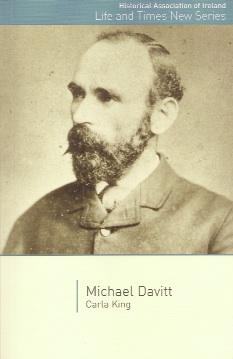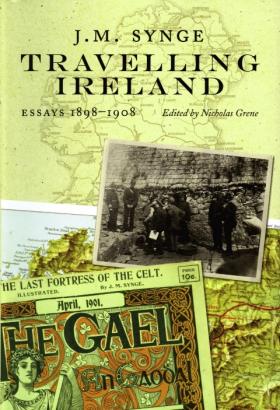Bookworm
Published in Book Reviews, General, Issue 5 (Sep/Oct 2009), Reviews, Volume 17 Notwithstanding the depressive effect of the phrase ‘back to school’ (should it be banned from shop windows?), it’s that time of year again. Leaving Cert, A-level and undergrad history students can take some solace from the latest in the Historical Association of Ireland’s ‘Life and Times New Series’ (general editor Ciaran Brady), Carla King’s Michael Davitt (University College Dublin Press, 122pp, €17, ISBN 9781906359324).
Notwithstanding the depressive effect of the phrase ‘back to school’ (should it be banned from shop windows?), it’s that time of year again. Leaving Cert, A-level and undergrad history students can take some solace from the latest in the Historical Association of Ireland’s ‘Life and Times New Series’ (general editor Ciaran Brady), Carla King’s Michael Davitt (University College Dublin Press, 122pp, €17, ISBN 9781906359324).
UCD Press has also continued to roll out its ‘Classics of Irish History’ series (general editor Tom Garvin). Paul Bew and Patrick Maume introduce and annotate Wilfrid Ewart’s A journey in Ireland 1921 (180pp, €24, ISBN 9781906359171), first published in 1922. A meticulous and intelligent observer, Ewart, from an English gentry background, finds himself caught between fellow-feeling for embattled British forces and dismay for the state to which Ireland has been reduced. John Horgan writes a biographical introduction to his grandfather John J. Horgan’s Parnell to Pearse: some recollections and reflections (400pp, €24, ISBN 9781906359294), based on his personal knowledge of the panoply of historical figures from Parnell to Pearse and on his own involvement as an activist and observer in the turbulent period that witnessed the extinction of the Irish Party. Donal McCartney and Pauric Travers introduce and edit Words of the dead Chief: being extracts from the public speeches and other pronouncements of Charles Stewart Parnell from the beginning to the close of his memorable life (202pp, €20, 9781906359423), originally compiled by Jennie Wyse-Power. When originally published with an introduction by Anna Parnell shortly after her brother’s death in 1892, it was a best-seller and quickly went out of print. Anne Markey introduces and edits Joseph Campbell’s post-1916 translation of ten of Patrick Pearse’s Short stories (160pp, €20, ISBN 9781906359201), first published in Irish between 1905 and 1916, which sympathetically portray life in Connemara. Marta Ramón introduces and edits James Stephens’s The birth of the Fenian movement: American diary, Brooklyn 1859 (140pp, €20, 9781904558910), which uncovers the difficulties facing the movement’s founders and offers an insight into mid-nineteenth-century Irish-American life. For Sir Walter Ralegh in Ireland by Sir John Pope Hennessy, see Hiram Morgan’s review on p. 59.
Another notable re-publication is J. M. Synge’s Travelling Ireland: essays 1898–1908, edited and introduced by Nicholas Grene (Lilliput Press, 240pp, €25, ISBN 9781843511571). Nearly half of the 27 essays are from the ‘In the Congested Districts’ series published in the Manchester Guardian in June and July 1905, and consequently have a harder journalistic edge than Synge’s more romantic depictions of rural life. He also had a thoroughly modern approach to his work, travelling by bicycle, composing directly onto a typewriter and always carrying a camera.
 What do Winston Churchill, Margaret Thatcher, Deng Xiaoping, Bill Gates, Warren Buffet, Omar Shariff, Hercule Poirot and James Bond all have in common? They all play or played bridge, according to Seamus Dowling, author of Thank you, partner. The history of bridge in Ireland (Liberties Press, 414pp, €29.99, ISBN 9781905483662). Even if you’ve never played the game this comprehensive survey has much to offer, not least by dishing the dirt on the frequently acrimonious conflicts that have marked the various incarnations of the Contract Bridge Association of Ireland (The elephant, bridge and Partition!). We learn that golf clubs, some of whom are currently derided for their restrictive attitudes to women members, were in the vanguard of women’s rights in the early twentieth century by providing the only venues where women could play cards in public.
What do Winston Churchill, Margaret Thatcher, Deng Xiaoping, Bill Gates, Warren Buffet, Omar Shariff, Hercule Poirot and James Bond all have in common? They all play or played bridge, according to Seamus Dowling, author of Thank you, partner. The history of bridge in Ireland (Liberties Press, 414pp, €29.99, ISBN 9781905483662). Even if you’ve never played the game this comprehensive survey has much to offer, not least by dishing the dirt on the frequently acrimonious conflicts that have marked the various incarnations of the Contract Bridge Association of Ireland (The elephant, bridge and Partition!). We learn that golf clubs, some of whom are currently derided for their restrictive attitudes to women members, were in the vanguard of women’s rights in the early twentieth century by providing the only venues where women could play cards in public.
‘. . . There’s nothing here but war where the murdering cannons roar . . .’ So says the chorus of Paddy’s Lamentation, written at the height of the American Civil War, one of the very few (only?) Irish emigrant songs to discourage emigration to the United States. In Green, blue and grey: the Irish in the American Civil War (Collins Press, 336pp, €16.99, ISBN 97811905172986), Cal McCarthy recounts how tens of thousands of Irishmen fought in every important action of the war, on both sides. For civilian readers, who wouldn’t know a brigade from a battalion, there are very useful appendices on ‘Organisational structures’, ‘Basic weapons and tactics’, and a comprehensive list of all Irish units involved in the conflict.
Another foreign war in which the Irish were involved, according to Conor Kostick, was the First Crusade over 1,000 years ago (HI 11.1, Spring 2003, pp 12–13). While there is no discernible Irish content in his The Siege of Jerusalem: crusade and conquest in 1099 (Continuum Books, 212pp, £20, ISBN 9781847252319), readers will find the retelling of this epic tale—how hundreds of thousands of men, women and children left their homes in western Europe and marched for three years over thousands of miles—irresistible. This is a beautifully illustrated book, including diagrams of siege-engines and ‘3D’-style maps of the Holy City.
Bookworm has been keeping an eye on the Skibbereen and District Historical Society, and if its 2009 annual Journal (Vol. 5, 168pp, €10, ISSN 16496833) is anything to go by, the society is in rude health. This is a marvellously eclectic collection, ranging from the fiction of Sommerville and Ross to bardic schools, loan societies and the Poor Law union. From the pages of the Skibbereen Eagle we learn that the town’s worst flood occurred on 26 September 1875, when a local, Paddy Keating, caught an 8lb salmon in Main Street! And like the Skibbereen Eagle of old, this journal is not afraid to cast its eye beyond these shores. Also included is a very thought-provoking article on ‘Charles Darwin (or, the preservation of favoured races in the struggle for life)’ by Perry O’Donovan. HI
















